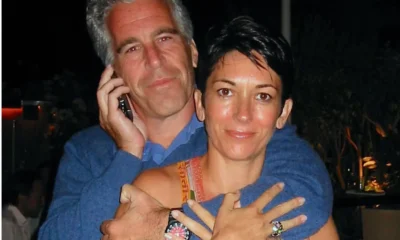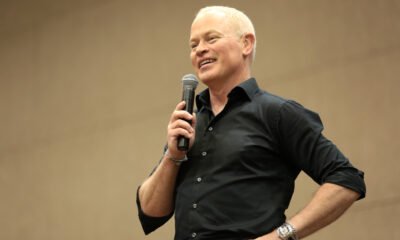Entertainment
Heather Gay to Jen Shah: I’m No Longer Your B-tch! on January 26, 2024 at 4:34 pm The Hollywood Gossip
Heather Gay is finally speaking her truth.
The Real Housewives of Salt Lake City star stirred up quite a controversy and a rather in-depth mystery last year when she showed up on set with a black eye.
At the time, Gay refused to explain how she got this injury.
A few weeks ago on air, however, Gay pointed her finger at Jen Shah.
Heather Gay breaks down here on the Real Housewives of Salt Lake City reunion. (Bravo)
“I had to ride hard for [Jen] and I had to lie for her,” Gay told her colleagues, simply saying the wound was caused during some sort of night out with Shah.
She didn’t provide any further details.
“I blacked out. I don’t know what happened. … I cannot speak to anything other than I walked to my room and I blacked out and I woke up with a black eye,” Gay added, emphasizing, though, that Shah was the culprit.
Shah, of course, is serving a five-year sentence behind federal bars for orchestrating a nationwide telemarketing scheme.
From left: Monica Garcia, Andy Cohen, Heather Gay, Lisa Barlow. (Bravo)
This past Tuesday night, meanwhile, Gay was asked for more on the incident by Andy Cohen during part three of the show’s reunion special.
“Honestly, it was a lot of drinking and the next morning I woke up with the black eye, I knew I’d gotten it from Jen,” Heather told Cohen.
“I didn’t know how, but I knew I’d gotten it from Jen. She was the first person I texted, she came in the room, she said, ‘Did I give that to you?’ I said, ‘Don’t worry, I’ll cover.’”
Heather Gay and Andy Cohen are featured on the stage of the reunion. (Bravo)
Gay admitted she covered for Shah out of fear.
“I had been covering for her for three years. I wasn’t going to to stop with the black eye. I was that in,” Gay continued.
“And I was too scared to say anything. I was terrified to say it, I was still scared to say it at reunion, I was still scared to say it in Bermuda.”
Gay did finally come clean during the aforementioned episode, which took place in Bermuda, because she was calling out Monica Garcia (who has since been fired by Bravo) at the time.
Gay went on to apologize to her cast members during the reunion, along with the network and audience for lying about the bruise for so long.
Whitney Rose, Meredith Marks, Monica Garcia, Andy Cohen, Heather Gay, Lisa Barlow, and Angie Katsanevas sit on the Reunion stage on The Real Housewives of Salt Lake City Season 4. (Image Credit: Bravo)
“I didn’t know how to navigate it myself. It was a horrible situation … I was scared and I did what I always do, I deflect with humor. It was in poor taste, it was horrible,” she said on air.
And when it comes to Shah?
“She was never my friend. She pretended to be my friend and I fell for it. I will not fall for a pretend friend again. I’m still worried about the retaliation.”
The reunion segment wrapped up with Cohen giving Gay the chance to send a message to the imprisoned Shah.
“I would say, I’m no longer your bitch and I regret believing in you. I regret turning on all of you in her defense.
“I regret fighting her fight, I regret disrespecting my children, my family and my opportunity here. And I would say I’m glad you’re in prison, or I might not have had the guts to do it otherwise.”
This purple and feathery reunion look was so good for Jen Shah. But her behavior was so, so bad. (Image Credit: Bravo)
Shah, for her part, actually fired back last month at Gay.
“BRAVO, if I punched Heather in her eye, you guys would have footage to prove it,” wrote Shah on social media.
“It’s clear the show can’t live without me since I was brought up at the beginning, middle and end of season 4.”
Heather Gay to Jen Shah: I’m No Longer Your B-tch! was originally published on The Hollywood Gossip.
[[{“value”:”Heather Gay has a message for Jen Shah. The Real Housewives of Salt Lake City star is at last standing up for herself.
Heather Gay to Jen Shah: I’m No Longer Your B-tch! was originally published on The Hollywood Gossip.”}]]
The Hollywood Gossip Read More
Entertainment
What We Can Learn Inside 50 Cent’s Explosive Diddy Documentary: 5 Reasons You Should Watch

50 Cent’s new Netflix docuseries about Sean “Diddy” Combs is more than a headline-grabbing exposé; it is a meticulous breakdown of how power, celebrity, and silence can collide in the entertainment industry.
Across its episodes, the series traces Diddy’s rise, the allegations that followed him for years, and the shocking footage and testimonies now forcing a wider cultural reckoning.

1. It Chronicles Diddy’s Rise and Fall – And How Power Warps Reality
The docuseries follows Combs from hitmaker and business icon to a figure facing serious criminal conviction and public disgrace, mapping out decades of influence, branding, and behind-the-scenes behavior. Watching that arc shows how money, fame, and industry relationships can shield someone from scrutiny and delay accountability, even as disturbing accusations accumulate.

2. Never-Before-Seen Footage Shows How Narratives Are Managed
Exclusive footage of Diddy in private settings and in the tense days around his legal troubles reveals how carefully celebrity narratives are shaped, even in crisis.
Viewers can learn to question polished statements and recognize that what looks spontaneous in public is often the result of strategy, damage control, and legal calculation.
3. Survivors’ Stories Highlight Patterns of Abuse and Silence
Interviews with alleged victims, former staff, and industry insiders describe patterns of control, fear, and emotional or physical harm that were long whispered about but rarely aired in this detail. Their stories underline how difficult it is to speak out against a powerful figure, teaching viewers why many survivors delay disclosure and why consistent patterns across multiple accounts matter.
4. 50 Cent’s Approach Shows Storytelling as a Tool for Accountability
As executive producer, 50 Cent uses his reputation and platform to push a project that leans into uncomfortable truths rather than protecting industry relationships. The series demonstrates how documentary storytelling can challenge established power structures, elevate marginalized voices, and pressure institutions to respond when traditional systems have failed.
5. The Cultural Backlash Reveals How Society Handles Celebrity Accountability
Reactions to the doc—ranging from people calling it necessary and brave to others dismissing it as a vendetta or smear campaign—expose how emotionally invested audiences can be in defending or condemning a famous figure. Watching that debate unfold helps viewers see how fandom, nostalgia, and bias influence who is believed, and why conversations about “cancel culture” often mask deeper questions about justice and who is considered too powerful to fall.
Entertainment
South Park’s Christmas Episode Delivers the Antichrist

A new Christmas-themed episode of South Park is scheduled to air with a central plot in which Satan is depicted as preparing for the birth of an Antichrist figure. The premise extends a season-long narrative arc that has involved Satan, Donald Trump, and apocalyptic rhetoric, positioning this holiday episode as a culmination of those storylines rather than a stand‑alone concept.
Episode premise and season context
According to published synopses and entertainment coverage, the episode frames the Antichrist as part of a fictional storyline that blends religious symbolism with commentary on politics, media, and cultural fear. This follows earlier Season 28 episodes that introduced ideas about Trump fathering an Antichrist child and tech billionaire Peter Thiel obsessing over prophecy and end‑times narratives. The Christmas setting is presented as a contrast to the darker themes, reflecting the series’ pattern of pairing holiday imagery with controversial subject matter.
Public and political reactions
Coverage notes that some figures connected to Donald Trump’s political orbit have criticized the season’s portrayal of Trump and his allies, describing the show as relying on shock tactics rather than substantive critique. Commentators highlight that these objections are directed more at the depiction of real political figures and the show’s tone than at the specific theology of the Antichrist storyline.
At the time of reporting, there have not been widely reported, detailed statements from major religious leaders focused solely on this Christmas episode, though religion-focused criticism of South Park in general has a long history.
Media and cultural commentary
Entertainment outlets such as The Hollywood Reporter, Entertainment Weekly, Forbes, Slate, and USA Today describe the Antichrist arc as part of South Park’s ongoing use of Trump-era and tech-world politics as material for satire.
Viewer guidance and content advisory
South Park is rated TV‑MA and is intended for adult audiences due to strong language, explicit themes, and frequent use of religious and political satire. Viewers who are sensitive to depictions of Satan, the Antichrist, or parodies involving real political figures may find this episode particularly objectionable, while others may view it as consistent with the show’s long‑running approach to controversial topics. As with previous episodes, individual responses are likely to vary widely, and the episode is best understood as part of an ongoing satirical series rather than a factual or theological statement.
Entertainment
Sydney Sweeney Finally Confronts the Plastic Surgery Rumors

Sydney Sweeney has decided she is finished watching strangers on the internet treat her face like a forensic project. After years of side‑by‑side screenshots, “then vs now” TikToks, and long comment threads wondering what work she has supposedly had done, the actor is now addressing the plastic surgery rumors directly—and using them to say something larger about how women are looked at in Hollywood and online.

Growing Up on Camera vs. “Before and After” Culture
Sweeney points out that people are often mistaking normal changes for procedures: she grew up on camera, her roles now come with big‑budget glam teams, and her body has shifted as she has trained, aged, and worked nonstop. Yet every new red‑carpet photo gets folded into a narrative that assumes surgeons, not time, are responsible. Rather than walking through a checklist of what is “real,” she emphasizes how bizarre it is that internet detectives comb through pores, noses, and jawlines as if they are owed an explanation for every contour of a woman’s face.
The Real Problem Isn’t Her Face
By speaking up, Sweeney is redirecting the conversation away from her features and toward the culture that obsesses over them.
She argues that the real issue isn’t whether an actress has had work done, but why audiences feel so entitled to dissect her body as public property in the first place.
For her, the constant speculation is less about curiosity and more about control—another way to tell women what they should look like and punish them when they do not fit. In calling out that dynamic, Sweeney isn’t just defending herself; she is forcing fans and followers to ask why tearing apart someone else’s appearance has become such a popular form of entertainment.

 Entertainment2 weeks ago
Entertainment2 weeks agoWicked Sequel Disappoints Fans: Audience Verdict on For Good

 News4 weeks ago
News4 weeks agoYolanda Adams Questions Traditional Views on God’s Gender, Audience Reacts

 Entertainment2 weeks ago
Entertainment2 weeks agoAriana & Cynthia Say They’re in a ‘Non‑Demi Curious, Semi‑Binary’ Relationship… WTF Does That Even Mean?

 News3 weeks ago
News3 weeks agoEpstein Files to Be Declassified After Trump Order

 News4 weeks ago
News4 weeks agoTrump Throws Epstein Files at Clinton’s Door

 Entertainment4 weeks ago
Entertainment4 weeks agoAriana Grande’s Red Carpet: When Fans Forget Boundaries

 Entertainment4 weeks ago
Entertainment4 weeks agoHollywood’s Kiss or Miss Policy: Why Saying No Got Neal McDonough Blackballed

 Entertainment3 weeks ago
Entertainment3 weeks agoJimmy Cliff, Reggae Legend and Star of ‘The Harder They Come,’ Dies at 81


























